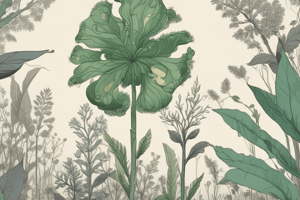Podcast
Questions and Answers
What type of special stem does the ginger plant have that grows horizontally?
What type of special stem does the ginger plant have that grows horizontally?
- rhizome (correct)
- corn
- tuber
- bulb
A flower with stamens, pistils, and no petals is classified as a complete flower.
A flower with stamens, pistils, and no petals is classified as a complete flower.
False (B)
What happens to the branches of Group 1 when terminal buds are removed?
What happens to the branches of Group 1 when terminal buds are removed?
The existing branches will not grow longer, but new branches will form.
In Group 2, the existing branches will grow longer, but ____ new branches will form.
In Group 2, the existing branches will grow longer, but ____ new branches will form.
Match each group of plants with their expected growth outcomes:
Match each group of plants with their expected growth outcomes:
Which group of plants will grow normally, both in length and in producing new branches?
Which group of plants will grow normally, both in length and in producing new branches?
Lateral buds are responsible for the length growth of stems.
Lateral buds are responsible for the length growth of stems.
In the experiment, what is the main role of the terminal buds?
In the experiment, what is the main role of the terminal buds?
A flower that lacks petals is termed an ____ flower.
A flower that lacks petals is termed an ____ flower.
Match the traits used in grading the essay with their descriptions:
Match the traits used in grading the essay with their descriptions:
Study Notes
Experiment on Bud Effects
- Elizabeth conducts an experiment to study the impact of terminal and lateral buds on branching in three groups of potted woody plants.
Groups Overview
- Group 1: Terminal buds removed.
- Group 2: Lateral buds removed.
- Group 3: Both terminal and lateral buds intact.
Predictions for Plant Growth
-
Group 1:
- New branches will emerge and grow.
- Existing branches remain unchanged since length growth occurs only at terminal buds.
-
Group 2:
- Existing branches will elongate.
- New branches will not be produced since lateral buds are required for branching.
- New lateral buds will form on the new growth portions of the stem.
-
Group 3:
- Plants will grow normally with both length and branching.
- Presence of both bud types allows for continued growth and branching.
Grading Rubric Components
-
Focus:
- Excellent prediction includes accurate growth predictions for all groups.
- Good relates functions of buds to all groups but with minor errors.
- Fair covers predictions for two groups.
- Poor only predicts the growth of one group.
-
Detail:
- Excellent correlation between bud functions and all three groups.
- Good relates functions to two groups.
- Fair connects functions to one group.
- Poor describes functions but lacks scenario connection.
-
Organization:
- Excellent organization is achieved through clear paragraph structure with logical progression.
- Poor organization results in a disjointed presentation of ideas.
Studying That Suits You
Use AI to generate personalized quizzes and flashcards to suit your learning preferences.
Description
This quiz examines Elizabeth's experiment on the effects of terminal and lateral buds on the branching of woody plants. It covers predictions for growth in three different groups of plants with varying bud conditions. Test your understanding of plant biology and experimental predictions based on these scenarios.




